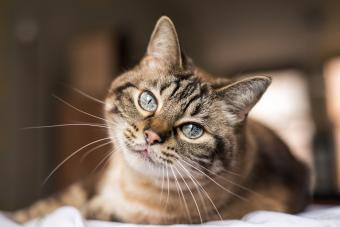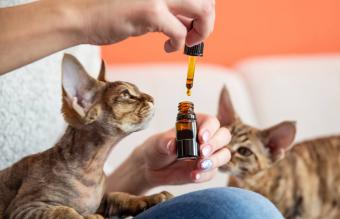
With many types of cat litter on the market, deciding which option is best for your kitty and your lifestyle can be difficult. Each has its advantages and disadvantages, and the best one for you depends on some specific factors. We’ve listed the pros and cons for each of the eight types of cat litters available so you can decide for yourself.
Clay Cat Litter

Clay litter has been around since the 1940s and is still one of the most popular cat litter types out there. It's simply dried, pulverized clay, which absorbs urine and gives the cat something to bury their feces under.
Pros
- Clay litter is more cost-effective than other types of litter.
- It's available everywhere, even grocery stores.
- It absorbs liquid very well, which helps keep odor under control.
Cons
- Most clay litter is sourced through strip mining, which has a negative impact on the environment.
- It's not biodegradable or flushable.
- Cats can track clay crumbs around on their paws, making sweeping up after them a constant chore.
- Clay litter is incredibly heavy and can be cumbersome to carry up and down stairs.
- The dust from this litter can be harmful to cats with asthma or respiratory issues.
Related: A Look at Safest Cat Litter Debates: Which Is Best?
Clumping Clay Litter

Clumping litter is frequently made with a clay base that pulls or clumps together into balls when wet. Different brands have different levels of clumping, and some pull together tighter than others. This may be due to where and how your cat urinates in the box.
Pros
- It's widely available.
- Clumping litter is much easier to scoop than others.
- It has better odor control than strictly clay litter.
Cons
- If a cat's paws are wet, the litter can clump up and get stuck to their feet.
- It's extremely heavy.
- Like regular clay litter, it has negative environmental consequences.
- Not flushable or biodegradable.
- If a cat eats clay litter, it will expand and can cause a blockage. For this reason, it's not usually recommended for kittens.
- Most clumping litters are easy for cats to track outside the box.
Placing the litter box on a bathmat so the cat has to wipe their feet when they emerge might help reduce litter-track throughout the house.
Scented Litters

At about the same time that clumping litter was introduced, cat litter brands began to feature extra odor control in the form of scented litters. Some use essential oils or other fragrance additives.
Pros
- Can have a more pleasant scent for humans versus the unscented varieties.
- They can help mask the smell or urine and feces.
- Scented litters come in endless scents, and around the holidays, you can even find pumpkin spice cat litter!
Cons
- Many cats are sensitive to smells and may not like the scent to the point where they decide to avoid the litter box.
- Often, the scent simply mixes with the urine smell rather than masking it.
- Cats who are sensitive to fragrances can develop skin irritation or respiratory symptoms with these litters.
Want to switch cat litter types? Do it gradually, and if your cat resists the change, back off or slow down in your introduction.
Crystal Litters

"Crystal" litters are actually silica-based and non-toxic. They look like little beads that are super-absorbent, so you don't need to use as much in the pan at one time, although it does need to be deep enough to avoid urine pooling.
Pros
- These litters absorb urine, the moisture in feces, and the accompanying odors.
- Because they expand, they can cause intestinal blockages if a cat (or kitten) decides to eat some.
- Crystal litters tend to be low-tracking because of the size of the crystals.
- There's little to no dust with this litter type.
- The litter is a lot lighter in weight than clay.
Cons
- There's some evidence that long-term use and breathing in the silica dust could be dangerous.
- When the crystals' absorption capacity has been exceeded, cat urine will start to pool and it's time to change the cat litter.
- Crystal litters can be more expensive than other kinds.
- Not biodegradable.
Many crystal litters have health-monitoring abilities and can potentially help you detect problems based on the color the litter turns after coming into contact with urine.
Paper-Based Litter

If you're looking for a biodegradable cat litter option, you'll be happy to know there's actually litter made from paper. Paper-based litters are formed into large pellets that don't easily get caught in paw pads, making them fairly track free. The paper is also extremely absorbent but don't usually clump.
Pros
- Great eco-friendly option that's biodegradable.
- It doesn't track much thanks to the large pellets.
- Non-clumping paper litter is a very low dust option and usually the recommended type for cats with asthma.
- This type won't cause harm to your cat if they eat a few pellets.
Cons
- Most paper litters don't clump, so scooping isn't quite as easy as with other types.
- There are some clumping paper litters out there, but they do contain additives.
- The odor control isn't as great as other litters.
- Litters made from recycled newspaper can contain ink, but Purina, the manufacturer of Yesterday's News, assures owners that most modern inks are organic or soy-based. "The process used to make Yesterday's News neutralizes these inks so there will be no residue left on your cat's paws or fur."
Related: 7 Homemade Cat Litter Substitutes
Wood-Based Litter

Wood litters usually come as pellets, which are made from wood shavings. Pine is the most popular type, but you can also find cedar or fir. The pellets turn into sawdust when they get wet, so you know exactly where your cat urinated and can scoop away the waste.
Pros
- Wood cat litter is biodegradable, and some owners even compost it instead of throwing it in the trash.
- Some brands are even flushable.
- This cat litter type doesn't produce dust.
- It has a nice, natural wood smell.
- This type of litter tends to be more expensive than most.
Cons
- Some cats don't like the smell of the pellets.
- It can be tricky to scoop because the pellets dissolve into sawdust when wet.
- Wood litter typically doesn't clump.
- It can take a little while for cats to get used to the sensation of the large pellets.
Only use pine or wood pellets as litter if it's made specifically for cats because others can contain dangerous oils or additives.
Corn Litter

It might sound odd to make cat litter out of corn, but this is actually one of the most popular litter types out there, for many reasons. Corn litter is a natural, biodegradable choice that doesn't negatively impact the environment like clay litter does. It's made of compressed corn cobs or dried corn kernels and is naturally clumping.
Pros
- Corn litter is sustainable and biodegradable.
- You can actually flush most corn-based litters down the toilet!
- It's highly-absorbant and naturally clumping, which makes scooping a breeze.
- It has fairly good natural odor control.
Cons
- The tiny pellets and pieces can easily track out of the litter box.
- Some owners don't like the earthy, corn smell.
- Corn litters can grow mycotoxins if exposed to moisture, so you'll need to be careful about where you store your litter and clean the litter box regularly.
Related: How Often to Change Cat Litter: Quick Guide by Type
Wheat Cat Litter

This natural litter is made from wheat, which is a renewable resource. Depending on the brand you go with, it can look like tiny granules or pellets. Wheat provides natural odor control and is practically dust-free.
Pros
- Some brands may be flushable because the litter is completely biodegradable.
- It naturally clumps and is easy to scoop.
- These products are frequently lower in dust and in tracking than other litters, so they may be a safer litter for cats that have respiratory issues or who are bothered by litter between their toes.
- It has natural odor control, which does a decent job of eliminating odors.
- Wheat products are often recommended as the best litter for kittens because of their safety and the fact that they're harmless if your kitten eats some.
Cons
- It has a natural, wheaty smell that takes some getting used to.
- Tends to be more expensive than other litters.
- Wheat litter isn't as widely available as clay litter.
Choose the Best Litter Type for You & Your Cat
Cats can be just as choosy about their litter as their owners can. If you have cats in your house, then cat litter is a big part of your life. Buy the type that best suits your home, your budget, and your cat. The result will have you both living together in greater comfort than ever.







